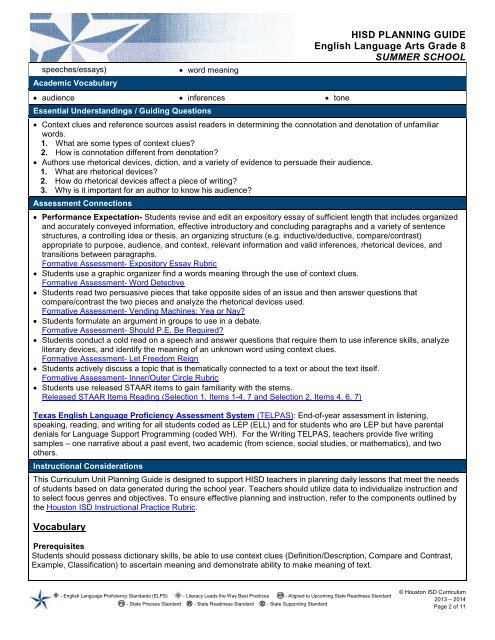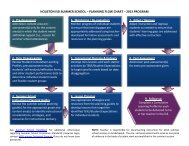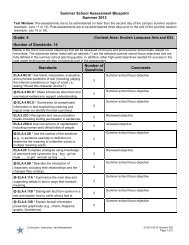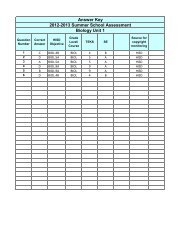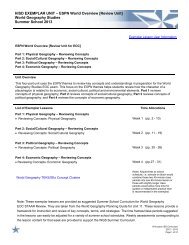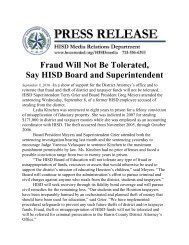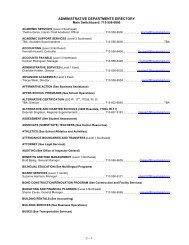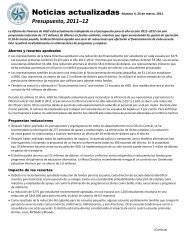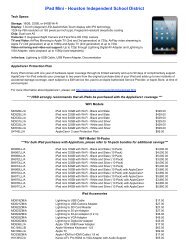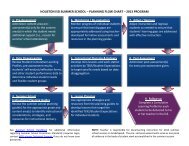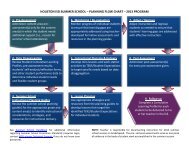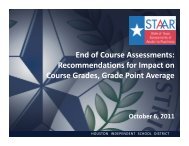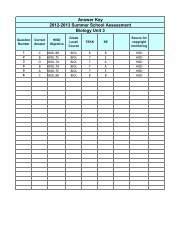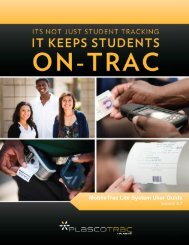speeches/essays)Academic Vocabulary• word meaning• audience • inferences • toneEssential Understandings / Guiding QuestionsHISD PLANNING GUIDEEnglish Language Arts Grade 8SUMMER SCHOOL• Context clues and reference sources assist readers in determining the connotation and denotation of unfamiliarwords.1. What are some types of context clues?2. How is connotation different from denotation?• Authors use rhetorical devices, diction, and a variety of evidence to persuade their audience.1. What are rhetorical devices?2. How do rhetorical devices affect a piece of writing?3. Why is it important for an author to know his audience?Assessment Connections• Performance Expectation- Students revise and edit an expository essay of sufficient length that includes organizedand accurately conveyed information, effective introductory and concluding paragraphs and a variety of sentencestructures, a controlling idea or thesis, an organizing structure (e.g. inductive/deductive, compare/contrast)appropriate to purpose, audience, and context, relevant information and valid inferences, rhetorical devices, andtransitions between paragraphs.Formative Assessment- Expository Essay Rubric• Students use a graphic organizer find a words meaning through the use of context clues.Formative Assessment- Word Detective• Students read two persuasive pieces that take opposite sides of an issue and then answer questions thatcompare/contrast the two pieces and analyze the rhetorical devices used.Formative Assessment- Vending Machines: Yea or Nay?• Students formulate an argument in groups to use in a debate.Formative Assessment- Should P.E. Be Required?• Students conduct a cold read on a speech and answer questions that require them to use inference skills, analyzeliterary devices, and identify the meaning of an unknown word using context clues.Formative Assessment- Let Freedom Reign• Students actively discuss a topic that is thematically connected to a text or about the text itself.Formative Assessment- Inner/Outer Circle Rubric• Students use released STAAR items to gain familiarity with the stems.Released STAAR Items Reading (Selection 1, Items 1-4, 7 and Selection 2, Items 4, 6, 7)Texas English Language Proficiency Assessment System (TELPAS): End-of-year assessment in listening,speaking, reading, and writing for all students coded as LEP (ELL) and for students who are LEP but have parentaldenials for Language Support Programming (coded WH). For the Writing TELPAS, teachers provide five writingsamples – one narrative about a past event, two academic (from science, social studies, or mathematics), and twoothers.Instructional ConsiderationsThis Curriculum <strong>Unit</strong> <strong>Planning</strong> <strong>Guide</strong> is designed to support HISD teachers in planning daily lessons that meet the needsof students based on data generated during the school year. Teachers should utilize data to individualize instruction andto select focus genres and objectives. To ensure effective planning and instruction, refer to the components outlined bythe Houston ISD Instructional Practice Rubric.VocabularyPrerequisitesStudents should possess dictionary skills, be able to use context clues (Definition/Description, Compare and Contrast,Example, Classification) to ascertain meaning and demonstrate ability to make meaning of text. - English Language Proficiency Standards (ELPS) - Literacy Leads the Way Best Practices - Aligned to Upcoming State Readiness Standard- State Process Standard R - State Readiness Standard S - State Supporting Standard© Houston ISD Curriculum2013 – 2014Page 2 of 11
Instructional ConsiderationsBackground Knowledge for TeacherExplicitly teach how to use a dictionary and thesaurus. See Literature Grade 8 in Resources.HISD PLANNING GUIDEEnglish Language Arts Grade 8SUMMER SCHOOLInstructional Accommodations for Diverse Learners The regular use of a bilingual dictionary leads to faster acquisition of English. Develop vocabulary bylistening to selections read aloud. See Instructional Strategies for Read-Aloud strategies for ELLs. The use of Brick and Mortar Cards can help ELLs with the acquisition of vocabulary. Students aregiven five “brick” cards with academic vocabulary and are instructed to organize them in a way they thinkmakes sense. Afterward, students have to link the cards together using their primary language or English.They write the language they are using on “mortar” cards that tie the concepts together. See Navigatingthe ELPS in the English Language Arts and Reading Classroom in Resources. (ELPS C.1g)Concentrate on the use of context clues and word analysis. Draw students’ attention to any informal language andidioms encountered in the reading selections. Assist students in using context clues to discover the author’s intendedmeaning. Use Think-Alouds to model proper use of context clues and self-questioning. See Self-Questioning inInstructional Strategies. For information on Think-Alouds, see ELA Best Practices MS, Literature Grade 8, and CommonContext Clues in Best Practices Toolkit in Resources. (ELA.8.2B)Formative Assessment- Have students work in groups to play a game that utilizes context clues. This allows studentsto practice their skills and affords an opportunity to assess student progress. See Formative Assessment- WordDetective in Assessment Connections.ReadingPrerequisitesStudents should have background knowledge of persuasive texts and rhetorical devices.Background Knowledge for TeachersThis unit focuses on persuasive texts. For suggested texts, see Literature Grade 8 in Resources.Students may require more practice making inferences. Be sure to model extensively how to make inferences throughThink-Alouds. See ELA Best Practices MS in Resources. (ELA.8.Fig19D)Instructional Accommodations for Diverse Learners For ELLs, provide a graphic organizer to accompany inference Think-Alouds. See Observation andInference Chart in Instructional Strategies.Remind students of the SMELL strategy for taking notes. Explain to students that similar questions can be used to beginanalyzing and evaluating a speech. These questions assist students in discovering the context of a persuasive text. Besure to model all strategies. For struggling students, fill in various areas of the Determining Context Chart. SeeInstructional Strategies for SMELL Note-taking and Determining Context Chart. (ELA.8.7A)Instructional Accommodations for Diverse Learners Allow ELLs the opportunity to read linguistically adapted texts as needed. (ELPS C.4e)Once students have determined the context, assist students in analyzing the text. Review rhetorical devices. Explainthat some rhetorical devices are stylistic (diction, repetition aphorisms, epigraphs, allusions, caricatures, tone, similes,metaphors, imagery, syntax) and others are content-based (facts, opinions, statistics, testimonials, false assumptions,incorrect premises). Introduce and explain persuasive appeals: pathos, logos, and ethos. Have students identify andcomment on the appeals found in persuasive texts. Reiterate that the purpose of all devices is to influence an audience.Have students begin reading excerpts from contemporary speeches that contain examples of specific elements andappeals. Explain that analyzing a text requires more than identifying elements or devices. Students must also be able toprovide commentary. See Instructional Strategies for Find the Appeals in Contemporary Speeches. See Resource - English Language Proficiency Standards (ELPS) - Literacy Leads the Way Best Practices - Aligned to Upcoming State Readiness Standard- State Process Standard R - State Readiness Standard S - State Supporting Standard© Houston ISD Curriculum2013 – 2014Page 3 of 11


